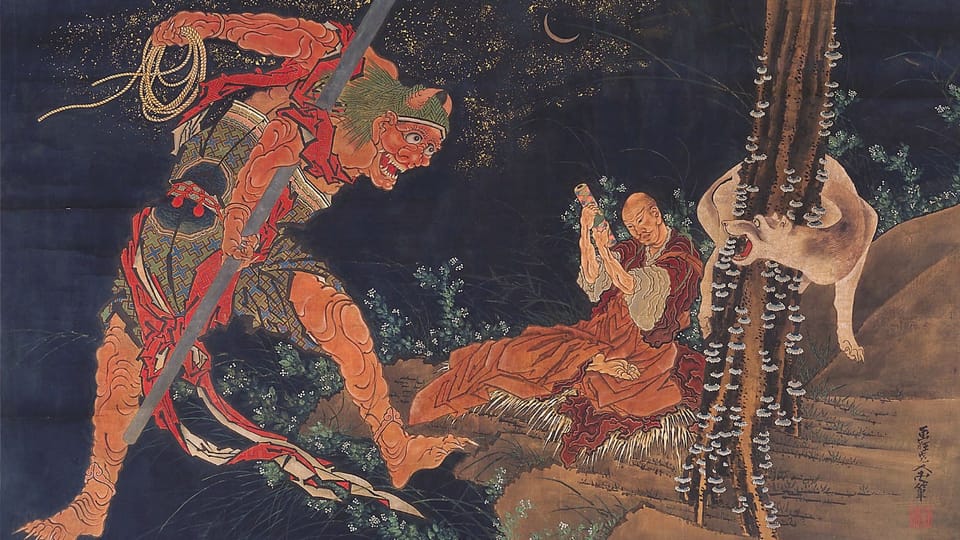Axes and Katanas: When Norse Myths Collide with Samurai Legends

VIKINGS vs SAMURAI is lopsided. Yeah, I’ll admit it. I grew up on Norse mythology. Thor, Loki, Odin—those gods were my rock stars. Their stories are baked into our Western brains so hard you don’t even realize it’s there. But Kamakura period Japan? Oh, man, that was homework, and let me tell you, it paid off.
The Kamakura era (1185–1333) isn’t just some dusty old chapter in a textbook. It’s the origin story for the samurai, think Batman, but with katanas and way more Zen. This was when Japan traded its aristocratic silk robes for armor and discipline, putting the shogunate in charge and the warriors front and center. It was a period of transformation where old Shinto gods and Buddhist philosophy didn’t just coexist, they threw a party, blended their myths, and created something raw, powerful, and haunting.
It all kicked off with Minamoto no Yoritomo, the original shogun, fresh off the Genpei War. Imagine two clans, the Minamoto and the Taira, duking it out like the Clash of the Titans. The war ends, and Yoritomo plants his flag in Kamakura, flipping the script on Japan’s political order. The Heian court’s poetry and elegance? Gone. Enter a world of martial values, discipline, and a warrior ethos that defines not just people but also mythology.
And here’s where it gets juicy. Buddhism, which had already been simmering in Japan, exploded during this era. Pure Land, Zen, Nichiren—they all show up to the party, each with their own philosophical swagger. You’ve got tales of karmic justice, because if you screw up in life, karma’s got a front-row seat waiting for you in the afterlife. Pure Land Buddhism painted redemption like a blockbuster epic: trust Amida Buddha, and he’s your ticket to paradise. Meanwhile, Zen taught samurai how to sharpen their minds like swords. And Nichiren? He’s the firebrand shouting, “Lotus Sutra or bust!”
But let’s not forget the OGs, Shinto’s kami. These divine spirits weren’t overshadowed by Buddhism. Instead, they doubled down. The sun goddess Amaterasu? She wasn’t just a deity; she became the poster girl for imperial legitimation. Meanwhile, Susanoo, the storm god, was every samurai’s spirit animal. Brave, chaotic, and always ready to throw down.
And then there’s Hachiman, the god of war and archery. He’s not just a guy with a bow, he’s the samurai’s wingman. The shrines to him, like Tsurugaoka Hachimangū, became ground zero for warriors looking to bless their blades before battle. Hachiman didn’t just protect; he inspired. Think of him as the patron saint of don’t mess with me.
The mythology wasn’t all gods and glory, though. The Kamakura era’s folk tales are straight out of a supernatural horror anthology. Oni and yūrei, demons and ghosts, weren’t just set dressing, they were moral tests, allegories for the warrior’s internal and external battles. You’ve got stories like “Hoichi the Earless,” where a blind musician plays for the dead and pays the price. It’s a chilling reminder that in this world, you don’t mess with the supernatural unless you’re ready to face the consequences.
Even the arts got in on the action. Noh theater started taking root, blending myth and performance into something transcendent. Slow, deliberate movements, masks that seem to breathe, and stories that take you out of this world and drop you into a spiritual headspace. And then there’s the visual stuff, emakimono (illustrated scrolls) that turned history into myth, and statues of Amida Buddha that felt more alive than some of the people bowing to them.
The Kamakura era didn’t just shape the samurai; it shaped Japan’s soul. Its mythology—its blend of Shinto, Buddhism, and the warrior code—isn’t just history. It’s a living, breathing thing that resonates in modern Japan. Those myths are everywhere, from anime to theater to the way Japanese culture handles honor and redemption.
So, yeah, when I say VIKINGS vs SAMURAI, I’m not just talking about swords clashing in the moonlight. I’m talking about two titanic cultures with mythologies so deep, they rewrite how we see the world. And while I may have had to do my homework for Kamakura Japan, let me tell you, the payoff is a story that’s anything but lopsided. It’s a bloody, beautiful collision of gods, warriors, and everything in between.
